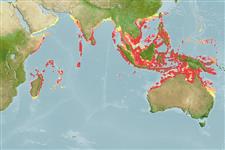Environment / Climate / Range
Ecology
Marine; freshwater; brackish; pelagic-neritic; anadromous (Ref. 51243); depth range 10 - 55 m (Ref. 12260). Tropical, preferred 28°C (Ref. 107945); 25°N - 30°S, 43°E - 155°E (Ref. 54703)
Indo-West Pacific: Madagascar, and from Durban, South Africa to the Gulf of Oman and the coasts of India. From the Andaman Sea to Indonesia and the Philippines, southeast to the Arafura Sea (Ref. 9819), northern and western Australia and Papua New Guinea.
Length at first maturity / Size / Weight / Age
Maturity: Lm 13.5 range ? - ? cm
Max length : 16.0 cm SL male/unsexed; (Ref. 188)
Dorsal
spines
(total): 0;
Dorsal
soft rays
(total): 0;
Anal
spines: 0;
Anal
soft rays: 34 - 42. Belly with usually 18 or 19 + 8 or 9, total 26 to 28 scutes, strongly keeled. Eye large, lower jaw projecting; and upper jaw with a toothed hypo-maxillary bone between hind tip of pre-maxilla and lower bulge of maxilla blade. Dorsal fin origin near midpoint of body. Scales with upper and lower vertical striae slightly overlapping each other at center of scales.
Occurs in coastal areas, entering mangrove areas and estuaries, and freshwater as well (e.g. in the Pangani River, Tanzania), thus apparently fully euryhaline. Marketed fresh and may be dried or salted (Ref. 5284). Regarded as an excellent bait in the tuna fishery.
Life cycle and mating behavior
Maturity | Reproduction | Spawning | Eggs | Fecundity | Larvae
Whitehead, P.J.P., 1985. FAO Species Catalogue. Vol. 7. Clupeoid fishes of the world (suborder Clupeioidei). An annotated and illustrated catalogue of the herrings, sardines, pilchards, sprats, shads, anchovies and wolf-herrings. FAO Fish. Synop. 125(7/1):1-303. Rome: FAO. (Ref. 188)
IUCN Red List Status (Ref. 115185)
CITES (Ref. 94142)
Not Evaluated
Threat to humans
Harmless
Human uses
Fisheries: commercial; bait: usually
More information
ReferencesAquacultureAquaculture profileStrainsGeneticsAllele frequenciesHeritabilityDiseasesProcessingMass conversion
Tools
Special reports
Download XML
Internet sources
